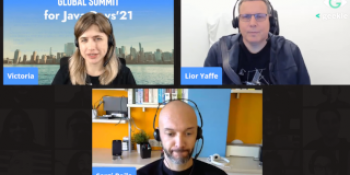Six Ardor Blockchain-Based Use Cases Showcased at the Media Arts & Design Blockchain Conference
19 Mayo 2020

Six Ardor Blockchain-Based Use Cases Showcased at the Media Arts & Design Blockchain Conference
We live in a digital world. The media industry includes a wide range of professionals and companies dedicated to the production of digital products, from creative and artistic works to games, which also includes using gamification in industries like education or environment.
When talking about assets that live in the digital world, we see a significant number of implementations of blockchain technology. Very often, these are not included in specialized blockchain conferences, which tend to give more attention to finance, logistics, and other business implementations.
Drexel University’s Department of Digital Media, in collaboration with the Education Arcade at MIT, the LIVE LAB of Texas A&M, and the Department for Arts and Cultural Sciences of Donau-Universität Krems, hosted the first Media Arts and Design Blockchain Conference. Conducted on May 2nd and 3rd, 2020, its goal was to show blockchain implementations in the field and fill the gap of blockchain applications beyond pure business use cases.
The conference was supposed to happen face-to-face in Philadelphia but moved to an online format due to the Coronavirus outbreak. All the video recordings are available online. In this article, we are proud to highlight six Ardor use cases that were showcased in this 2-day conference.
Ardor Use Case #1: Triffic
Lior Yaffe explained why Ardor is especially suitable for this industry and showcased the Triffic App based on augmented reality and rewards.
Lior Yaffe, core-developer of Ardor and co-founder of Jelurida, used the first half of his presentation to highlight a few unique features of how Ardor can be used for the game economy and to manage aspects such as “secrets”, randomness, recording achievements, and gamification. The second half of his presentation showcased real use cases implemented on Ardor. It focused on Triffic, a mobile app that uses augmented reality and gamification to allow users to collect GPS tokens based on mobility.
Triffic at the Media Arts & Design Blockchain Conference
Ardor Use Case #2: HotCity
Ernst Gebetsroither presented HotCity, a project that uses gamification and crowdsourcing as tools to generate data for energy-oriented neighborhood planning.
Ernst Gebetsroither presented HotCity in his talk under the topic of “Gamification as a Means of Generating Data for Energy-Oriented Neighborhood Planning.” HotCity uses gamification and crowdsourcing as tools to generate data for energy-oriented neighborhood planning.
HotCity is a research project funded by the Austrian Research Agency FFG and led by the Austrian Institute of Technology (AIT). It explores how gamification, machine learning, and crowdsourcing can help to locate waste heat sources in order to reuse the heat. The HotCity application uses the Ignis child chain to implement a reward system for participants who report inefficient usage of heat sources.
The applied gamification framework can be seen as one of the most advanced implementations of game metrics so far, due to the usage of lightweight smart contracts. Learn more in this video.
HotCity at the Media Arts & Design Blockchain Conference
Ardor Use Case #3: Cycle4Value
Thomas Wernbacher showcased Cycle4Value, a blockchain-based solution that rewards cyclists for regular cycling.
Thomas Wernbacher showcased Cycle4Value in his talk about “Why (Open) Blockchains Will Win in the End: Findings on the Success of Networks in the Fields of Sociology, Psychology, Arts & Biology.”
Cycle4value is a blockchain-based solution that rewards cyclists for regular cycling using so-called “cycle tokens” in a safe and transparent process of value generation. The project is funded by the Austrian Research Promotion Agency (FFG) and conducted by Bike Citizens and the Donau-Universitaet Krems.
Thanks to the blockchain, a transparent and low-threshold reward model for the promotion of cycling is developed. The solution is built on the Ignis child chain of Ardor, taking advantage of the distributed infrastructure offered by the Ardor parent chain that takes care of the decentralized consensus algorithm.
Cycle4Value at the Media Arts & Design Blockchain Conference
Ardor Use Case #4: Gallery Defender
Lloyd Donelan, Nick Muniz, and Michael Black presented Gallery-Defender, a research project that explores the application of blockchain technologies in a game-based learning tool.
The goal of the project was to build a game that tests the knowledge gained by the player and records the player achievements on the blockchain. The immutability of DLT technologies makes blockchain systems the perfect technology to secure learning achievements and educational credentials.
The project, that is live on the Ardor mainnet, was developed together with Dr. Alexander Pfeiffer from The MIT Education Arcade from the Massachusetts Institute of Technology (MIT), the Center for applied game studies from Danube-University Krems, and the Live Lab from Texas A&M University. Watch the full presentation.
Gallery Defender at the Media Arts & Design Blockchain Conference
Ardor Use Case #5: Tarasca
Palheiro, co-founder with Ana Santiso, presented Tarasca, a company that produces physical and digital art and games with educational purposes, and uses blockchain tokenization.
The Tarasca game represents cards as blockchain assets with a specific supply depending on their nature: common, rare, or epic. The mechanics of the collection are encoded in a smart contract, therefore it is public and transparent. The lightweight smart contract (Ardor-based smart contracts) is used to digitize three processes: sale of cards, splitting payments between creators and Tarasca, and the management of a weekly jackpot for users. Learn more about this implementation in Palheiro’s presentation.
Tarasca at the Media Arts & Design Blockchain Conference
Ardor Use Case #6: ArdorRocks
Corrado Andriani presented ArdorRocks, a social network that rewards users’ participation with Rocks tokens.
Corrado Andriani is a telecommunication OS engineer from Switzerland and a long-time member of the Ardor and Nxt community. He presented the social network ArdorRocks as a hobby project based on blockchain technology. The problem of the current social networks, he explains, is that there are no rewards for content creators. ArdorRocks changes the game since users’ participation is rewarded with Rocks token, a digital asset created on the Ardor platform. The token can be transferred, traded, or sold within the Ardor platform. Users have to participate: they can contribute their ideas, they can post texts, they can comment, and each of these actions is rewarded with a certain amount of Rocks.
ArdorRocks is an excellent example of how easy it is to build a decentralized application on Ardor. The Ardor API allowed Corrado to construct this decentralized blockchain-based social network without having to deal with the complexities presented by blockchain technology. You can find all talks from the conference at https://ardor.rocks/members/mediaartsanddesignblockchainconference/.
ArdorRocks at the Media Arts & Design Blockchain Conference
A Successful Pioneer Conference, First of its Kind
The event, supported by the Education Arcade at MIT, the LIVE LAB of Texas A&M, the Department for Arts and Cultural Sciences of Donau-Universität Krems, and the Conceptualising Blockchain group of the University of Vaasa, was a success. The organizing committee decided to work on the 2021 edition as soon as the conference came to an end. For 2021, the conference will be hosted again by the Drexel university as an online conference, hoping that hybrid formats combining online and face-to-face sessions will be possible by then.
Links to the projects:
Gallery Defender’s academic paper, Blockchain in Gaming
Links of interest:
Conference: https://digm.drexel.edu/acelab/media-arts-and-design-blockchain-conference-2020/
Youtube - all the presentations: https://www.youtube.com/channel/UCS2roUzAtsozTwRxEu_SAtw
Organizers’ post-event press release: https://cmsw.mit.edu/media-arts-and-design/








